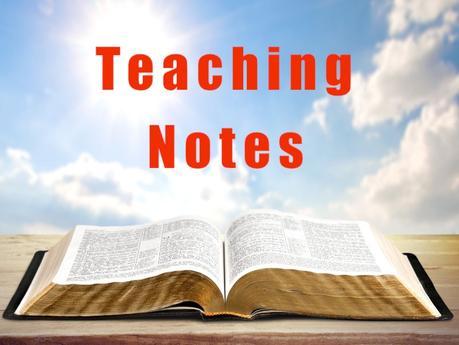Grace Thoughts
Teaching Notes: On Christian Apologetics (Part 4)

Teaching Notes are Bible studies we taught before GraceLife Ministries began publishing articles online in 1995. Some were presented as sermons, others as group studies.
Our hope is that these older studies will be a blessing to you in your life and ministry. Please use them in any way God leads you.
These teaching notes are from a series of studies about Christian Apologetics. If you have not read the first part of this series, we invite you to look at it here. [link]
[These notes are from a study presented 45 years ago.]
I. The Importance of the Resurrection
The greatest miracle of the New Testament was the resurrection of Jesus Christ. It was the supernatural seal of the New Covenant.
A. It was the personal miracle of the Messiah. This was God’s declaration that Jesus was the Son of God.
B. It is a major go in the plan of redemption. Death, burial and resurrection are at the center of the Gospel of Christ and the redemption of man.
C. It is the seal of our resurrection. We will be raised from the dead, the Bible says, because Jesus was raised from the dead.
D. It possesses great evidential value. The fact that He died, was buried, rose and came forth with an incorruptible body. This is evidence of our resurrection and new body.
II. Classification of the Evidence
A. Philosophical evidence
If we follow the rigorous methodology developed by philosophical investigations, a Christian theism can be constructed.
B. Theological evidence
Evidence for the resurrection fits into a religious system of profound metaphysical and religious significance. The resurrection is a great historical fact that is a great theological tenet.
C. Biblical evidence
The resurrection is conceivable, necessary, and actual. It can be proven from history and Biblical documents.
- Old Testament evidence – the Old Testament teaches the resurrection long before the fact.
- The evidence of Christ – Jesus plainly declared that He would die and be raised from the grave.
- The evidence from the Gospels and Acts – The writers of the four Gospel accounts and the Book of Acts overwhelmingly present the truth of the resurrection.
- The evidence of the remainder of the New Testament – All of the remaining Books give strong proof to the resurrection.
D. The evidence of Church history
The great historians of the Christian Church have always attested to the resurrection of Christ.
E. Inferential evidence
- The Early Church grew phenomenally because of the resurrection.
- Only the resurrection can adequately explain the power lives of the apostles.
- Only the resurrection could account for the conversion of Paul.
- Only the resurrection explains completely the empty tomb.
III. The impossibility of the Position of Unbelief
The New Testament very plainly teaches that the resurrection of Christ was physical.
A. Unbelief must present the Gospel account of the resurrection of Christ as completely unreliable, but this is contradictory to all historical inquiry.
B. Unbelief must completely destroy the witness of the Book of Acts,, but this is contradictory to all historical inquiry.
C. Unbelief must totally destroy the evidence of Pul’s writings, but this is contradictory to all historical inquiry.
D. Unbelief is caught between the natural and the supernatural elements in the Gospels. Unbelief cannot prove that Jesus did not live. Unbelief cannot prove that the Gospels are not historical and must stretch to try to prove parts as non-historical.
E. Unbelief must controvert the testimony in Hebrews, Peter’s epistles, John’s epistles, and the Revelation. Unbelief must also try to repudiate the person of James and his letter.
F. Unbelief must deny all of the Church Father’s testimony.
The burden of unbelief is too great to carry.
It is not surprising that the natural man cannot perceive the things of the Spirit. However, all proof lies in the hands of the unbeliever for history proves the reality of the resurrection of Jesus Christ.
Other Available Materials
Evidence That Demands a Verdict, Josh McDowell, Campus Crusade for Christ, 1972 (Chapter 10)
The Life and Times of Jesus the Messiah, Alfred Edersheim, Eerdmans Publishing, 1971 (Second Volume, Chapters 16 & 17)
Introductory Lectures in Systematic Theology, Henry Thiessen, Eerdmans Publishing, 1949 (Chapter 27)
A Calvin Treasury, Ed. William Keesecker, Harper & Bros. Publishers, 1961 (Pgs 110-111)
A Handbook of Christian Truth, Harold Lindsell & Charles Woodbridge, Fleming Revell Company, 1953 (Ch. 154)
Bible Truth, Oliver Greene, The Gospel House, Inc., 1968 (Chapter 4)
The Living God, Richard DeHaan, Zondervan Publishing, 1967 (Chapter 17)
Rightly Dividing the Word, Clarence Larkin, Clarence Larkin Estate, 1920 (Chapter 11)
Teaching Notes On Christian Apologetics eBook
© 1975, 2021
 ApostlesChrist's ResurrectionChristian ApologeticsGospel of ChristJesus Christ
ApostlesChrist's ResurrectionChristian ApologeticsGospel of ChristJesus Christ

Published by gracelifethoughts
Founder & Director of GraceLife Ministries View all posts by gracelifethoughts
